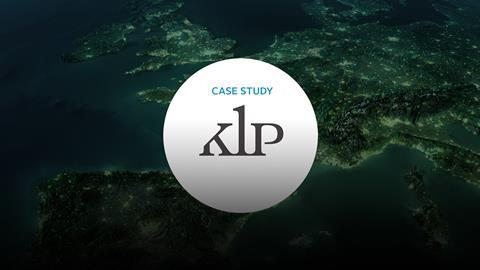| ORGANISATION DETAILS | |
|---|---|
| Name | KLP Kapitalforvaltning |
| Signatory type | Asset owner |
| Region of operation | Norway |
| Assets under management | NOK764.9bn |
| COVERED IN THIS CASE STUDY | |
|---|---|
| Name of fund | KLP AksjeGlobal Indeks I (ISIN: NO0010272412) |
| Asset class | Equity |
| Geography | MSCI World (developed world) |
| Environmental objective | Mitigation and adaptation |
| Economic activity | All |
KLP is a global investor, invested in over 7000 companies. Since 2000, aware of our responsibility as a global investor, we have steadily advanced ESG and sustainability efforts within our investments. A key challenge is data. The taxonomy will hopefully improve reporting and transparency, and not only for companies within the EU. This will make it easier to assess the long-term risks and opportunities of investments.
Other aspect you would like to mention?
KLP AksjeGlobal Indeks I is an index fund. However, in the instance that KLP finds that a company is in breach with its guidelines for investment it will exclude the company. Approximately 200 companies are excluded from the fund.
KLP’s work on responsible investment is rooted in international norms. KLP should exclude from its investments any companies that are associated with gross and/or systematic violations of generally accepted standards of business conduct.
Behaviour-based exclusion criteria
KLP should exclude companies from its investments where there is an unacceptable risk that they could contribute to or be responsible for:
- serious or systematic violations of human rights, and other serious or systematic violations of labour rights;
- serious violations of the rights of individuals in situations of war or conflict;
- severe environmental damage;
- acts or omissions that on an aggregate company level lead to unacceptable levels of greenhouse gas emissions;
- gross corruption;
- other particularly serious violations of fundamental ethical norms;
- other particularly serious violations of business ethics.
Product-based exclusion criteria
KLP shall not invest in companies that:
- produce weapons that violate fundamental humanitarian principles through their normal use;
- obtain more than 5 percent of their revenues from coal or oil sand-based activities (oil sand extraction, coal mining or coal-based power generation), produce more than 10,000 megawatts (MW) of energy from coal power, or extract more than 20 million tons of coal annually. The analysis should be forward-looking and take into consideration factors such as construction of new capacity, or plans that will reduce the share of revenues from coal-based activities or increase the share of renewable energy sources;
- produce tobacco, alcohol, gambling services or pornography.
Due diligence-based exclusions
KLP shall conduct due diligence in its investments and can decide due diligence-based divestments from companies if there is an unacceptable risk to contribute to complicity with KLP’s guidelines based on a combination of country, sector or company risk.
Taxonomy implementation
Principles, criteria, thresholds
We relied on MSCI data on sustainability impact to carry out this assessment. Given that the fund is invested in 1500 companies and no companies report on this yet, we rely on a proxy to help assess whether activities fall under the scope of the taxonomy or not. The sustainable impact metrics assess how much revenue a company generates from activities that are sustainable, such as for example solar power.
Do no significant harm assessment
We relied on MSCI data on controversies and global norms to carry out this assessment.
Social safeguards assessment
We relied on MSCI data on global norms to carry out this assessment.
Turnover/capex/opex alignment
We relied on MSCI data on revenue from sustainable impact activities and companies total revenue to carry out the assessment of the funds alignment with the taxonomy.
Additional comments
KLP is a passive investor involved in over 7000 companies. Therefore, we have to rely on MSCI data to carry out preliminary fund assessments.
Alignment results
We assessed the KLP AksjeGlobal Indeks fund, which comprises over 1600 listed companies in the developed world, tracking MSCI World. Initially, we leveraged MSCI data for sustainable impact, which has the following categories for environmental impact: climate change encompassing alternative energy, energy efficiency and green building (all mitigation and contribution) and natural capital encompassing pollution prevention, sustainable agriculture and sustainable water (all mitigation and contribution). We leveraged MSCI data on revenue from sustainable impact activities as a proxy for the categories under the taxonomy. We also included UN Global Compact (UNGC) compliance as a criteria. Approximately 5% of the revenues from the funds’ holdings were in line with the taxonomy.
Challenges and solutions
| NO. | CHALLENGE | SOLUTION |
|---|---|---|
| 1 | Lack of revenue data from activities defined in the taxonomy |
We followed MSCI advice to use the Sustainable Impact metrics, which calculate revenue from activities considered to be green |
| 2 | Many activities are not covered by MSCI | No solution |
| 3 | There is no MSCI do no significant harm (DNSH) assessment, only an assumption that activities that are defined as solutions do not cause harm. | No solution |
Recommendations
Large investors need to work with data providers and companies to deliver the data required to carry out assessments. Without this data, the reporting will have little value.












